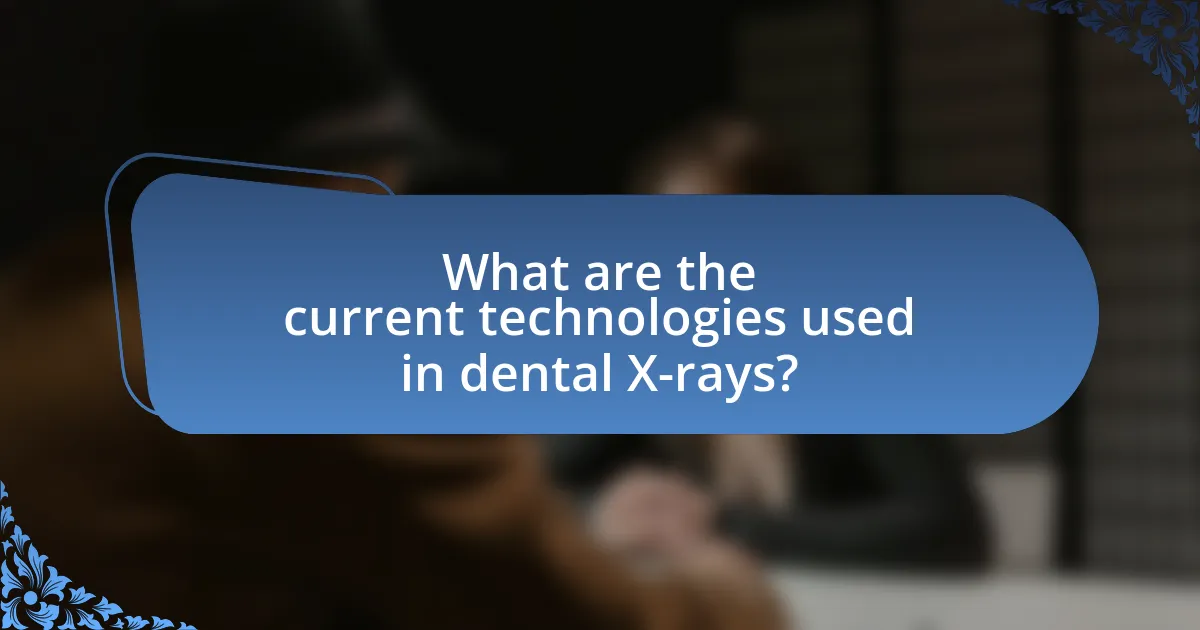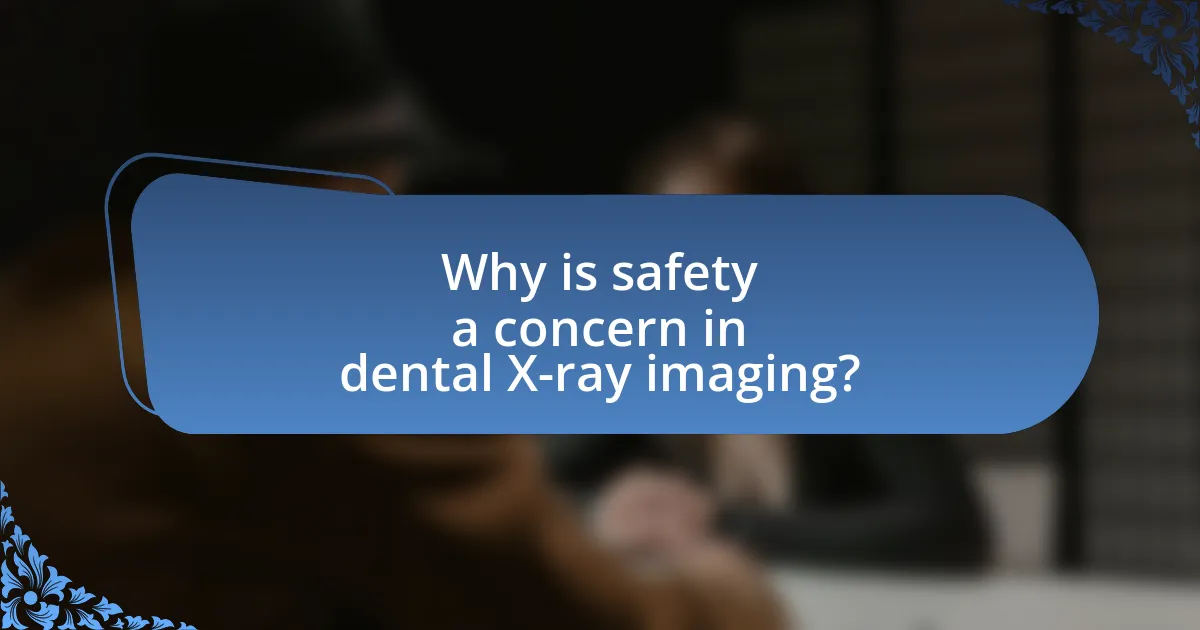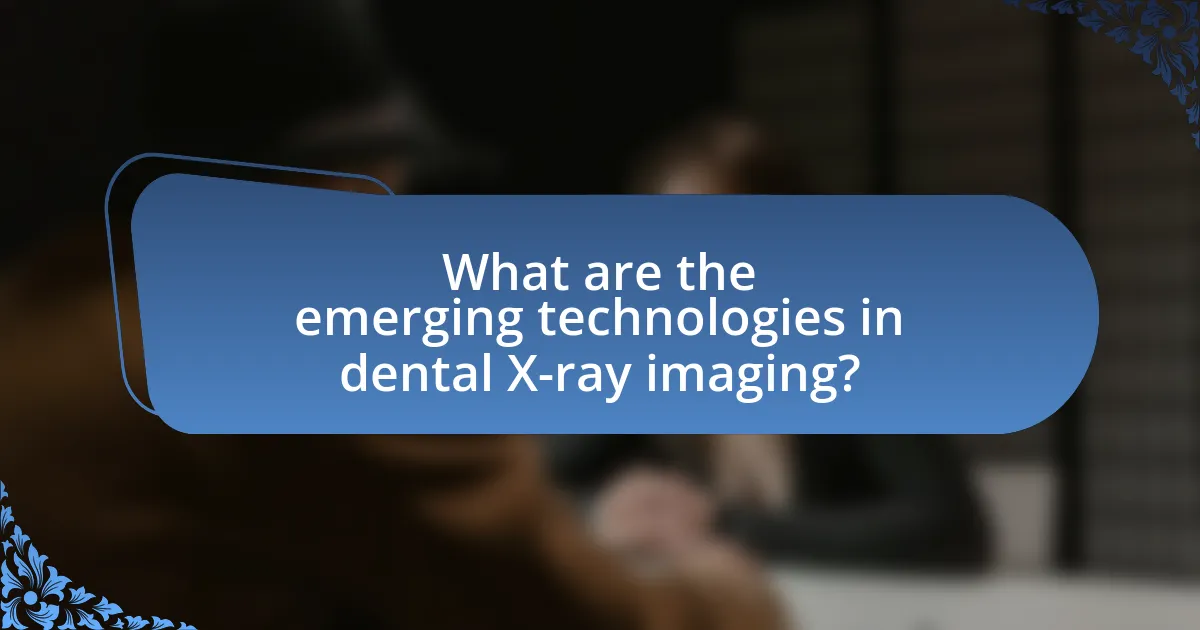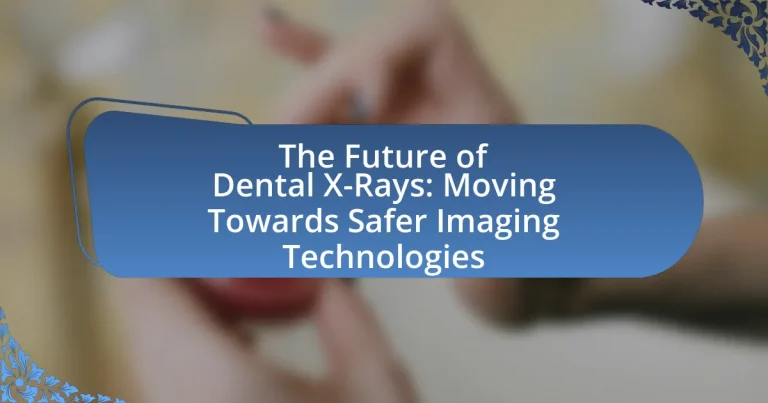The article focuses on the advancements in dental X-ray technologies, emphasizing the shift towards safer imaging methods. It details current technologies such as digital radiography, cone beam computed tomography (CBCT), and portable X-ray units, highlighting their benefits in reducing radiation exposure and enhancing diagnostic accuracy. The discussion includes traditional X-ray methods, their limitations, and the importance of safety measures in dental imaging. Additionally, it explores emerging technologies, including artificial intelligence integration, and outlines best practices for dental professionals to ensure patient safety while maintaining effective diagnostic capabilities.

What are the current technologies used in dental X-rays?
Current technologies used in dental X-rays include digital radiography, cone beam computed tomography (CBCT), and portable X-ray units. Digital radiography utilizes electronic sensors to capture images, significantly reducing radiation exposure compared to traditional film X-rays. Cone beam computed tomography provides three-dimensional imaging, allowing for more accurate diagnosis and treatment planning. Portable X-ray units offer flexibility and convenience, enabling imaging in various settings, including patients’ homes or remote locations. These advancements enhance diagnostic capabilities while prioritizing patient safety through reduced radiation doses.
How do traditional dental X-ray methods work?
Traditional dental X-ray methods work by using ionizing radiation to create images of the teeth and surrounding structures. In this process, a small amount of radiation is emitted from an X-ray tube and directed towards the patient’s mouth, where it passes through the teeth and jawbone. The radiation is absorbed at different rates by various tissues, with denser materials like enamel absorbing more radiation than softer tissues. This differential absorption creates a shadow image on a film or digital sensor placed opposite the X-ray source. The resulting image reveals details about tooth decay, bone loss, and other dental issues, allowing dentists to diagnose and plan treatment effectively. Traditional X-ray methods have been in use since the early 20th century and remain a standard diagnostic tool in dentistry.
What are the types of traditional dental X-rays?
The types of traditional dental X-rays include periapical, bitewing, and panoramic X-rays. Periapical X-rays capture the entire tooth, from the crown to the root, providing detailed images of the tooth structure and surrounding bone. Bitewing X-rays focus on the upper and lower teeth in a specific area of the mouth, allowing for the detection of cavities between teeth and assessing bone levels. Panoramic X-rays provide a broad view of the entire mouth, including all teeth, jaws, and surrounding structures, which is useful for evaluating overall dental health and planning treatment. These X-ray types are essential for diagnosing dental issues and planning appropriate interventions.
What are the limitations of traditional dental X-ray technologies?
Traditional dental X-ray technologies have several limitations, including exposure to ionizing radiation, limited diagnostic capability, and potential for image distortion. Exposure to ionizing radiation poses health risks, particularly with repeated use, as even low doses can accumulate over time. The diagnostic capability is limited because traditional X-rays primarily capture two-dimensional images, which can obscure underlying issues and lead to misdiagnosis. Additionally, image distortion can occur due to patient movement or improper positioning, affecting the accuracy of the interpretation. These limitations highlight the need for advancements in dental imaging technologies that prioritize patient safety and diagnostic precision.
What advancements have been made in dental X-ray technology?
Recent advancements in dental X-ray technology include the development of digital radiography, which significantly reduces radiation exposure and enhances image quality. Digital sensors provide immediate imaging results, allowing for quicker diagnosis and treatment planning. Additionally, advancements in cone beam computed tomography (CBCT) offer three-dimensional imaging, improving the visualization of dental structures and facilitating more precise interventions. These technologies have been validated by studies showing a reduction in radiation doses by up to 90% compared to traditional film X-rays, thereby enhancing patient safety while maintaining diagnostic accuracy.
How do digital X-rays differ from traditional X-rays?
Digital X-rays differ from traditional X-rays primarily in their imaging technology and processing methods. Digital X-rays utilize electronic sensors to capture images, allowing for immediate viewing and manipulation of the images on a computer, whereas traditional X-rays rely on film that must be developed chemically, which takes more time. Additionally, digital X-rays typically require less radiation exposure, with studies indicating that they can reduce radiation doses by up to 80% compared to conventional film X-rays. This reduction in radiation exposure enhances patient safety, aligning with the trend towards safer imaging technologies in dental practices.
What are the benefits of using digital dental X-rays?
Digital dental X-rays offer several benefits, including reduced radiation exposure, immediate image availability, and enhanced diagnostic capabilities. The radiation exposure from digital X-rays is significantly lower—up to 80% less—compared to traditional film X-rays, making them safer for patients. Additionally, images can be viewed instantly on a computer screen, allowing for quicker diagnosis and treatment planning. Digital X-rays also provide improved image quality, which aids in detecting dental issues more accurately, thus enhancing patient care.

Why is safety a concern in dental X-ray imaging?
Safety is a concern in dental X-ray imaging primarily due to the exposure to ionizing radiation, which can increase the risk of cancer and other health issues. Studies indicate that even low doses of radiation can have cumulative effects, particularly in vulnerable populations such as children. The American Dental Association emphasizes the importance of minimizing radiation exposure by using protective measures like lead aprons and thyroid collars, as well as adhering to the ALARA principle (As Low As Reasonably Achievable) to ensure patient safety during imaging procedures.
What are the risks associated with traditional dental X-rays?
Traditional dental X-rays expose patients to ionizing radiation, which carries risks such as potential damage to DNA and an increased risk of cancer over time. Studies indicate that the cumulative effect of radiation exposure can lead to a higher likelihood of developing malignancies, particularly in sensitive populations like children. Additionally, improper use or equipment malfunction can result in excessive radiation exposure, further elevating health risks. The American Dental Association emphasizes the importance of minimizing exposure by using protective measures, such as lead aprons and thyroid collars, to mitigate these risks.
How does radiation exposure affect patients?
Radiation exposure affects patients primarily by increasing the risk of developing cancer and causing tissue damage. Studies indicate that even low doses of radiation can lead to cellular mutations, which may result in malignancies over time. For instance, the National Cancer Institute reports that exposure to ionizing radiation is a known risk factor for various types of cancer, including leukemia and thyroid cancer. Additionally, radiation can cause acute effects such as skin burns and radiation sickness at higher doses, impacting patient health significantly.
What measures are in place to minimize risks during X-ray procedures?
To minimize risks during X-ray procedures, several measures are implemented, including the use of lead aprons, collimation, and dose optimization techniques. Lead aprons protect sensitive organs from radiation exposure, while collimation focuses the X-ray beam to the area of interest, reducing unnecessary radiation to surrounding tissues. Additionally, dose optimization techniques, such as adjusting exposure settings based on patient size and using digital imaging, help to ensure that the lowest effective dose is used. These practices are supported by guidelines from organizations like the American Dental Association, which emphasize the importance of minimizing radiation exposure while maintaining diagnostic quality.
What regulations govern dental X-ray safety?
The regulations that govern dental X-ray safety primarily include the National Council on Radiation Protection and Measurements (NCRP) recommendations, the American Dental Association (ADA) guidelines, and state-specific regulations. The NCRP provides standards for radiation exposure limits and safety practices, while the ADA offers guidelines for the safe use of dental radiography, emphasizing the ALARA (As Low As Reasonably Achievable) principle to minimize patient exposure. Additionally, each state has its own regulations that may require licensing for operators and specific safety protocols to ensure compliance with federal standards. These regulations collectively aim to protect patients and dental professionals from unnecessary radiation exposure during dental imaging procedures.
How do these regulations impact dental practices?
Regulations impact dental practices by mandating the adoption of safer imaging technologies, which enhances patient safety and reduces radiation exposure. Compliance with these regulations often requires dental practices to invest in updated equipment and training, ensuring that they meet safety standards set by organizations such as the American Dental Association and the FDA. For instance, the implementation of digital X-ray systems, which emit significantly lower radiation compared to traditional film X-rays, is a direct result of regulatory pressure aimed at improving patient care. This shift not only protects patients but also positions practices competitively in a market increasingly focused on safety and technological advancement.
What role do dental professionals play in ensuring safety?
Dental professionals play a critical role in ensuring safety by implementing protocols that minimize risks associated with dental procedures, particularly in the use of imaging technologies like X-rays. They are responsible for adhering to safety guidelines established by organizations such as the American Dental Association, which recommends using the lowest radiation dose necessary for diagnostic purposes. Additionally, dental professionals are trained to utilize protective measures, such as lead aprons and thyroid collars, to shield patients from unnecessary radiation exposure. Their expertise in selecting appropriate imaging techniques and ensuring proper equipment maintenance further enhances patient safety, as evidenced by studies showing a significant reduction in radiation exposure when safety protocols are followed.

What are the emerging technologies in dental X-ray imaging?
Emerging technologies in dental X-ray imaging include digital radiography, cone beam computed tomography (CBCT), and artificial intelligence (AI) integration. Digital radiography enhances image quality and reduces radiation exposure compared to traditional film X-rays, with studies showing up to 80% less radiation. CBCT provides three-dimensional imaging, allowing for better visualization of complex dental structures, which improves diagnostic accuracy. AI integration in dental imaging aids in detecting anomalies and streamlining the interpretation process, with research indicating that AI can match or exceed human diagnostic capabilities in certain scenarios.
How do new imaging technologies enhance safety?
New imaging technologies enhance safety by reducing radiation exposure and improving diagnostic accuracy. For instance, digital X-rays emit up to 90% less radiation compared to traditional film X-rays, significantly lowering the risk to patients. Additionally, advanced imaging techniques such as cone beam computed tomography (CBCT) provide three-dimensional views, allowing for more precise assessments and minimizing the need for repeat imaging. This combination of reduced exposure and enhanced clarity contributes to safer dental practices, ultimately protecting patient health.
What is the role of 3D imaging in dental diagnostics?
3D imaging plays a crucial role in dental diagnostics by providing detailed, three-dimensional representations of a patient’s oral structures. This advanced imaging technique enhances the accuracy of diagnoses, allowing dental professionals to visualize complex anatomical relationships, assess bone density, and identify pathologies that may not be visible with traditional 2D X-rays. Studies have shown that 3D imaging, such as Cone Beam Computed Tomography (CBCT), increases diagnostic confidence and improves treatment planning, particularly in implantology and orthodontics, where precise measurements are essential for successful outcomes.
How does cone beam computed tomography (CBCT) improve imaging safety?
Cone beam computed tomography (CBCT) improves imaging safety by significantly reducing radiation exposure compared to traditional computed tomography (CT) scans. CBCT utilizes a cone-shaped X-ray beam and a digital detector, allowing for high-resolution 3D images with lower doses of radiation, often up to 80% less than conventional CT. This reduction in radiation is crucial for patient safety, particularly in dental imaging where repeated exposures may occur. Studies have shown that the effective dose from CBCT can be as low as 5-10 microsieverts, compared to 50-100 microsieverts for conventional CT, thereby minimizing the risk of radiation-related complications.
What future trends can we expect in dental X-ray technology?
Future trends in dental X-ray technology include the increased use of digital imaging, advancements in low-dose radiation techniques, and the integration of artificial intelligence for enhanced diagnostic capabilities. Digital imaging allows for immediate access to high-quality images, reducing the need for retakes and minimizing patient exposure to radiation. Low-dose radiation techniques are being developed to further decrease the amount of radiation patients receive during X-ray procedures, aligning with safety protocols. Additionally, artificial intelligence is being integrated into dental imaging systems to assist in identifying dental issues more accurately and efficiently, improving overall patient care. These trends reflect a commitment to enhancing safety and effectiveness in dental diagnostics.
How might artificial intelligence influence dental imaging?
Artificial intelligence may significantly enhance dental imaging by improving diagnostic accuracy and efficiency. AI algorithms can analyze dental images to detect anomalies such as cavities, periodontal disease, and other dental conditions with higher precision than traditional methods. For instance, a study published in the Journal of Dental Research found that AI systems achieved an accuracy rate of over 95% in identifying caries in radiographs, surpassing the performance of experienced dentists. This capability not only aids in early detection but also reduces the likelihood of misdiagnosis, ultimately leading to better patient outcomes.
What innovations are being researched for safer imaging technologies?
Innovations being researched for safer imaging technologies include the development of low-dose X-ray systems, advanced digital imaging techniques, and the use of artificial intelligence to enhance image quality while reducing radiation exposure. Low-dose X-ray systems utilize improved detector technology to minimize the amount of radiation needed for effective imaging, significantly lowering patient risk. Advanced digital imaging techniques, such as cone-beam computed tomography (CBCT), provide high-resolution images with reduced radiation doses compared to traditional methods. Additionally, artificial intelligence algorithms are being integrated into imaging systems to optimize exposure settings and enhance diagnostic accuracy, further ensuring patient safety. These innovations are supported by studies indicating that advancements in imaging technology can lead to a substantial decrease in radiation exposure without compromising diagnostic quality.
What best practices should dental professionals follow for safe imaging?
Dental professionals should adhere to the ALARA principle (As Low As Reasonably Achievable) for safe imaging. This principle emphasizes minimizing radiation exposure to patients while obtaining necessary diagnostic information. Implementing digital radiography can significantly reduce radiation doses compared to traditional film-based methods, as studies indicate that digital systems can lower exposure by up to 80%. Additionally, using lead aprons and thyroid collars protects patients from unnecessary radiation. Regular equipment maintenance and calibration ensure optimal performance and safety. Training staff on proper imaging techniques further enhances safety by reducing the likelihood of retakes, which can increase exposure.


